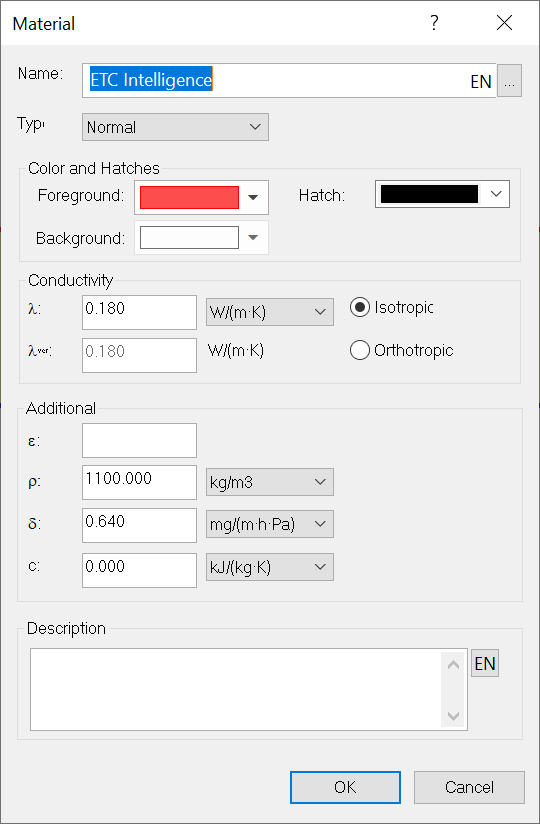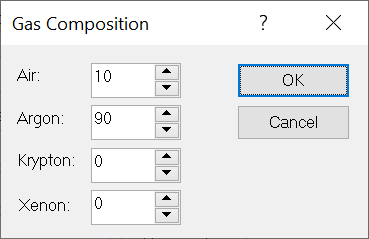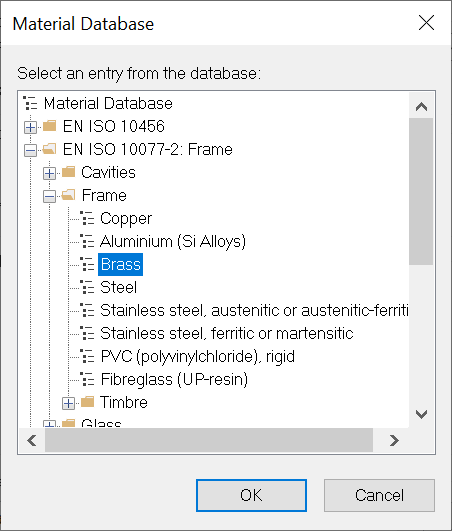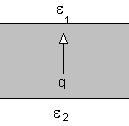Description
The dialog window Materials contains different fields to adjust the properties of a material. This dialog window can be activated from the Materials flyout.
|
|
Figure 2: Air cavity properties |
|
|
|
Figure 3: Gas properties |
|
|
|
Figure 1: Material dialog window |
|
|
|
Fields
Name |
Here the name of the material can be defined. You cannot leave this field empty, and the chosen name must be unique, i.e. it cannot be identical to the name of another material be it in an open document or be it in the application. Aside from these restrictions, you can choose any name. Click on the language abbreviation in this field to set the name in all supported languages. |
... |
After clicking on the "..." button, a dialog window appears with the materials database. From the database, you can choose an entry. The properties of this material will be assumed. |
Color |
Defines the color, which along with the hatch, characterizes the material in the construction. In the Materials flyout a small square before the name of a material defines its color. This color indicates the color of the material, which will be used when entering materials for a construction. You can assign materials to a domain with the Assign Properties tool or by dragging the desired material onto the domain. |
Hatch |
Defines the hatch, which along with the color, characterizes the material in the construction. |
Type |
There are three different types of materials: - Standard, for materials that do not have a temperature dependent thermal conductivity. - Air cavity, for small air cavities according to EN 10077-2. The equivalent thermal conductivities are calculated iteratively according to EN 10077-2. The precision and the maximum number of iterations can be defined on the corresponding page of the Options dialog window. - Gas, for gas of glass units according to EN 673 resp. ISO 15099. This type should only be used for longer, rectangular glass unit cavities. The equivalent thermal conductivities are calculated iteratively according to EN 673 resp. ISO 15099.
- vacuum for the modeling of vacuum. |
Isotropic/Orthotropic |
Defines whether the material is isotropic or orthotropic (thermal conductivities). This option is only available for standard materials. |
λhor, λver |
Thermal conductivity. If the material is isotropic, then the second field is not available. These values must only be entered for standard materials. |
ε1,ε2 |
Long-wave emission properties of the two surfaces in the direction of the heat flux, if the emission properties are not directly calculated byflixo (cf. option dialog window document cavities).
These values must only be entered for "Air Cavity" and "Gas". |
unventilated |
Determines whether the cavity is ventilated or not ventilated. According to EN 10077-2, air cavities are unventilated when they are completely surrounded by material with exterior exposure of less than 2mm. According to EN 10077-2, air cavities are ventilated when they have exposure greater or equal to 2mm but less than 10mm. If the air cavity is greater than this value, then a boundary condition must be set, and the air cavity cannot be assigned a "material". This option can only be selected for air cavities. |
Gas Type |
A small drop down list with the supported gas types: air, argon, xenon, krypton, or gas composite. If you choose "Gas composite", then the mixture can be changed by clicking on the ">" button. A small dialog window will appear where you alter the mixture's composition. The sum of all components must equal 100%. The type of gas must only be defined for glass unit gases. |
ε |
Standard emissivity of the material. This is used for calculations of the energy transport in air cavities according to EN ISO 10077-2. |
ρ |
Density of the material. *) |
m |
Diffusion resistance number of the material. The ratio of the vapor conductivity of the air to the vapor conductivity of a material. |
c |
Specific heat capacity of the material.*) |
Description |
Additional commentary Click on the language abbreviation in this field to set the name in all supported languages. |
*)These values are not needed by flixo calculations.





